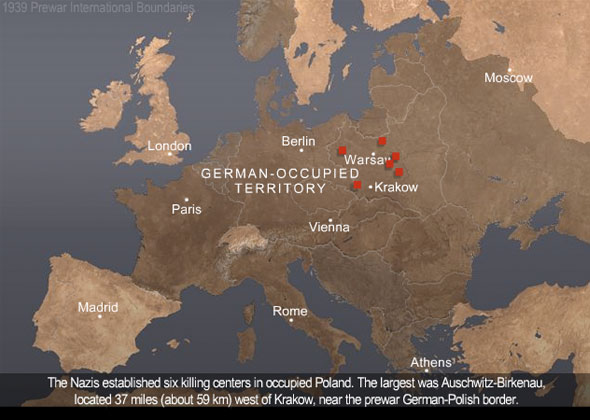

Auschwitz played a central role in the "Final Solution," the Nazi plan to murder the Jews of Europe. The Nazis deported Jews from nearly every European country to the Auschwitz II (Birkenau) killing center in occupied Poland. In all, at least 1.1 million Jews and tens of thousands of other people perished in Auschwitz.
— US Holocaust Memorial Museum
At the height of its power, Germany controlled most of continental Europe.
The Nazis established six killing centers in occupied Poland. The largest was Auschwitz, located 37 miles (about 59 km) west of Krakow, near the prewar German-Polish border.
The Auschwitz complex consisted of three main camps: the Auschwitz I concentration camp, the Auschwitz II (Birkenau) killing center, and the Auschwitz III (Monowitz) forced-labor camp.
A vast system of subcamps was also established in the region around Auschwitz and the prisoners were forced to work in various factories and industries.
In 1942, the Nazis began systematic deportations of Jews to Auschwitz. Trains arrived daily from nearly every corner of German-occupied Europe.
The new arrivals underwent a "selection" in which the SS staff declared most of them unfit for forced labor and sent them immediately to the gas chambers.
During 1943 and 1944, four large gas chambers and crematoria operated almost continuously in Auschwitz-Birkenau.
In October 1944, several hundred Jewish prisoners who had been forced to remove bodies from the gas chambers and operate the crematoria staged an uprising.
They blew up Crematorium IV and its adjacent gas chamber, and also killed several camp guards.
The SS quickly suppressed the revolt, killing the prisoners and later publicly hanging four women forced laborers who had smuggled the gunpowder used during the uprising.
In late 1944, SS staff forced prisoners to dismantle and dynamite the remaining gas chambers to destroy the evidence of mass killings.
As Soviet forces advanced in January 1945, the SS forced 60,000 prisoners from the Auschwitz camps on death marches toward the interior of Germany.
When the Soviets liberated Auschwitz at the end of January, only several thousand emaciated prisoners remained alive.
Over 1.1 million Jews, as well as tens of thousands of Christian Poles, Roma (Gypsies), and Soviet prisoners of war, perished at Auschwitz.
At the height of its power, Germany controlled most of continental Europe.
The Nazis established six killing centers in occupied Poland. The largest was Auschwitz, located 37 miles (about 59 km) west of Krakow, near the prewar German-Polish border.
The Auschwitz complex consisted of three main camps: the Auschwitz I concentration camp, the Auschwitz II (Birkenau) killing center, and the Auschwitz III (Monowitz) forced-labor camp.
A vast system of subcamps was also established in the region around Auschwitz and the prisoners were forced to work in various factories and industries.
In 1942, the Nazis began systematic deportations of Jews to Auschwitz. Trains arrived daily from nearly every corner of German-occupied Europe.
The new arrivals underwent a "selection" in which the SS staff declared most of them unfit for forced labor and sent them immediately to the gas chambers.
During 1943 and 1944, four large gas chambers and crematoria operated almost continuously in Auschwitz-Birkenau.
In October 1944, several hundred Jewish prisoners who had been forced to remove bodies from the gas chambers and operate the crematoria staged an uprising.
They blew up Crematorium IV and its adjacent gas chamber, and also killed several camp guards.
The SS quickly suppressed the revolt, killing the prisoners and later publicly hanging four women forced laborers who had smuggled the gunpowder used during the uprising.
In late 1944, SS staff forced prisoners to dismantle and dynamite the remaining gas chambers to destroy the evidence of mass killings.
As Soviet forces advanced in January 1945, the SS forced 60,000 prisoners from the Auschwitz camps on death marches toward the interior of Germany.
When the Soviets liberated Auschwitz at the end of January, only several thousand emaciated prisoners remained alive.
Over 1.1 million Jews, as well as tens of thousands of Christian Poles, Roma (Gypsies), and Soviet prisoners of war, perished at Auschwitz.
Auschwitz »
Elie Wiesel »
Elie Wiesel Timeline and World Events: 1928–1951 »
Sighet »
Tattoos and Numbers: The System of Identifying Prisoners at Auschwitz »
The Treatment of Soviet POWs: Starvation, Disease, and Shootings, June 1941–January 1942 »